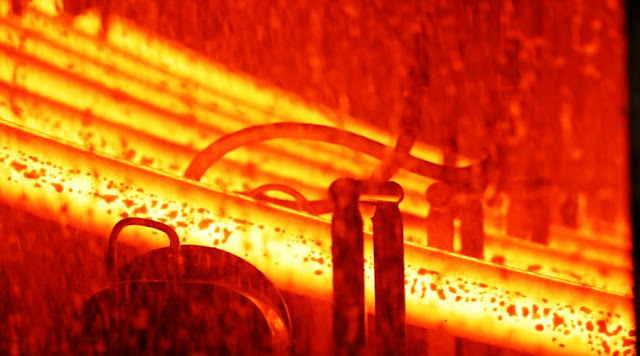Types of Continuous Casting Machine
Types of Continuous Casters
It can be classified in various forms.
According to the structure and shape, the continuous casting machine can be divided into:
Vertical caster,
Vertical bend caster,
Arc caster with straight section,
Arc caster,
Multi-radius oval caster,
Horizontal caster.
With the development of continuous casting technology, the research on wheeled continuous casting machine, especially thin slab continuous casting machine, has been carried out.
If it's distinguished according to the size and shape of the section cast by the continuous casting machine, continuous casting machine can be divided into:
Slab continuous casting machine,
Billet continuous casting machine,
Bloom continuous casting machine,
Round billet continuous casting machine,
Special-shaped section continuous casting machine,
Thin slab continuous casting machine.
The billet continuous casting machine also includes the rectangular billet continuous casting machine.
Usually, the casting section or the equivalent section area is larger than 200×200mm is called the bloom, and the section or the equivalent section area is less than 160×160mm, a rectangular blank with a width-thickness ratio greater than 3 is called a slab.
If it's distinguished by the number of strands that the continuous casting machine can cast under a common ladle,
It can be divided into
Single-strand,
Double-strand
Multi-strand continuous casting machines.
Features
Vertical Continuous Caster
Its shell cooling is relatively uniform, and it is not affected by the effect of bending straightening.
Therefore, it's not easy to generate internal cracks and surface cracks, which is more conducive to floating inclusions.
The section of the slab, the fixed length and the pulling speed are limited, and the problem of the slab belly deformation is more prominent due to the large hydrostatic pressure of the slab.
Vertical Bending Continuous Caster
The casting machine's tundish, mold, guide rollers, and dummy bars are distributed along the vertical line.
The tension leveler and the cutting machine are arranged horizontally, the pouring and cooling and solidification are completed in the vertical direction, and the top is bent 90° after complete solidification.
Entering the bending section and unloading the billet in the horizontal direction, the height of the casting machine is lower than that of the vertical type, which is convenient for transportation and can meet the requirements of longer fixed lengths.
Arc continuous casting machine
It is divided into three types:
Single-point straightening arc continuous casting machine,
Multi-point straightening arc continuous casting machine
Straight mold arc continuous casting machine.
The advantages and disadvantages of each of these three are described in detail:
The advantage of the single-point straightening arc ccm is that its height is lower than that of the vertical and vertical bending types,
so the equipment is light in weight, low in cost, convenient in installation and maintenance, and the static pressure of molten steel on the billet is small,
which can reduce the cost of The inner row and segregation caused by the belly are beneficial to increase the drawing speed and improve the quality of the slab.
Its disadvantage is that during the solidification of molten steel, non-metallic inclusions tend to focus in the arc, which easily causes uneven distribution of impurities in the slab;
The advantage of the multi-point straightening arc ccm is that the deformation rate of the solid-liquid interface is reduced when the slab is straightened with a liquid core, and no internal cracks are generated, which is beneficial to increase the pulling speed;
The advantage of straight mold arc ccm is that it has the advantages of vertical type, which is conducive to the floating of large inclusions and the even distribution of inclusions in the steel.
It's higher than the vertical bending type and has a lower construction cost.
Its shortcoming is that the billet shell on the outer arc side of the casting billet is stretched, the two-phase area is easy to cause crack defects, the equipment structure is complex, and the maintenance and repair are difficult.
Oval Continuous Caster
Compared with the arc, its height is greatly reduced, the hydrostatic pressure of the molten steel is low, the amount of the billet is small, the segregation of the internal crack center is improved, and the cost can be reduced by 20% to 30% compared with the arc.
However, the inclusions in the molten steel in the mold have almost no chance of floating, so the requirements for the molten steel are relatively strict.
Horizontal Continuous Caster
Its advantages are lower equipment height, secondary oxidation of molten steel, improved casting quality, free from bending and straightening, which is conducive to preventing cracks, simple equipment maintenance, and convenient problem solving.
The separation between the tundish and the mold joint is expensive, the lubrication between the mold and the billet is difficult, the mold does not vibrate when the billet is drawn, and is suitable for small billets, various castings, square billets under 200mm, round billets, and special steel.
The above is a general introduction to the five major categories of continuous casting machines and their advantages and disadvantages.
Hani Metallurgy's customers prefer vertical casters and horizontal casters.
If you have any needs or questions, please feel free to contact us.
E-mail: saleswn@hanrm.com / inquiry66@hanmetallurgy.com ( Daisy )



Comments
Post a Comment